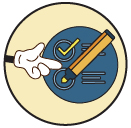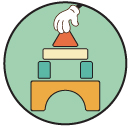This is part of the ADA Title 2 toolkit, a resource to help public entities start building digital accessibility strategies.
Documents include Word, Excel, PowerPoint, Google Docs, and PDFs to name a few.
These are tasks and examples to start building your document accessibility strategy. It is broken into three parts:
- Identify environment
- Put processes in place
- Fix existing content
 Identify environment
Identify environment
Goal: Discover content you have, the current state, and any opportunities you can build on.
Tasks
A task or process Pope Tech does for you or supports is marked with **.
- Inventory documents**
- Find who creates documents. This could be individuals or departments.
- Identify any content policies concerning document content that already exist.
- Learn about the current process or training for creating document content.
- Find potential opportunities to build on.
Potential opportunities
Here are examples of opportunities you might find:
- Pockets of teams that create the majority of document content.
- Outdated documents that are no longer needed.
- Documents that should be HTML web pages.
- Documents or document types that account for most of the views.
- Departments or teams that are willing or excited about the work.
- Processes or people that are already doing things well.
 Put processes in place
Put processes in place
Goal: Build a digital accessibility strategy that maintains your content’s accessibility.
Tasks
A task or process Pope Tech does for you or supports is marked with **.
- Leadership buy-in
- Meet with leadership to inform them of the current state, needs, goals, and get support for policies or resources (if needed).
- Follow up with leadership regularly.
- New process for maintaining accessibility
- Define and publish new organizational policies (if needed).
- Define the new process (that includes accessibility checks) for creating accessible documents.
- Create a plan to communicate the new process/policy and track adoption. This could include email campaigns, training, videos, incentives, and more.
- Create a training plan for those who work with documents. Topics should include what makes them accessible and how to use Adobe Acrobat, Word, Excel, and Powerpoint to make them accessible.
- Train people in the content management system if needed, so they create webpages instead of PDFs when needed.
- Training and communication
- Make a list of people you’ll communicate with about policies, processes, training, etc. (This could include people you have already identified, stakeholders, and other supporting groups).
- Carry out the communication plan.
- Host any necessary trainings or check in with people to make sure they’ve completed training.**
- Track adoption.
- Document expectations, processes, and training requirements for new hires and share with departments or teams.
- Start regular document testing
- Create a process for when there are inaccessible documents going forward. How will they be handled?
- Set up automatic accessibility testing for document content to monitor new documents.**
Potential opportunities
- Central teams that can support accessible document work.
- Creating a policy that dictates the standard and what happens if it isn’t met can keep everyone accountable.
- Sharing wins and progress publicly could motivate different teams to be a part of the effort.
- Start small with groups who want to be part of it. Share their wins and make changes for a larger rollout.
 Fix existing issues
Fix existing issues
Goal: Test existing content and fix accessibility issues.
Tasks
A task or process Pope Tech does for you or supports is marked with **.
- Determine if you’ll use 3rd party vendors for remediation.
- Determine in-scope existing content.**
- Test in-scope content and find opportunities.**
- Determine who is responsible for testing and updating existing document content.
- Document work in the central project management system that also has non-accessibility-related tasks (if relevant). Or, create a project tracker.**
- Set goals, starting with easy wins and opportunities.
- Create a plan for escalating potential blocks and barriers.
- Schedule regular check-ins with all applicable stakeholders and contributors.
Potential opportunities
- Reduce the scope by removing archived documents from the scope of work.
- Make PDFs HTML webpages instead. This is better for accessibility and easier to maintain.
Want a jump start?
Our accompanying webinar covers how to break up your accessibility efforts into more manageable pieces with real-life examples.
Start in the right direction quicker.
Our experts are here to help plan your ADA compliance strategy.
 How Pope Tech helps
How Pope Tech helps
Fixing existing issues and building an accessibility strategy that people actually adopt is difficult. It requires inventorying, training, continuous communication, planning, and tracking.
Pope Tech currently has a direct integration with Canvas. It has an Accessibility Guide, which helps instructors and designers find and fix issues, and dashboards to monitor results.

Identify your content
- Inventorying webpages
- Inventorying videos
- Inventorying PDFS
- Inventorying all Canvas course content

Prevent future issues
- Accessibility topic training for contributors
- Product training for organization
- Accessibility documentation to help people learn as they go
- Scheduled automated and manual testing
- Scheduled and automated reporting to anyone in your organization
- Easy-to-use dashboard to track progress and spot emerging issues
- User organization to make sure everyone has access to what they need

Test and fix existing issues
- Automated accessibility testing
- Guided manual testing flow
- Integrations with Jira, Asana, and email to send tasks directly to contributors
- API integrations to customize your flows
- Identifying issues with 3rd party tools
- Access to accessibility experts to answer any questions






